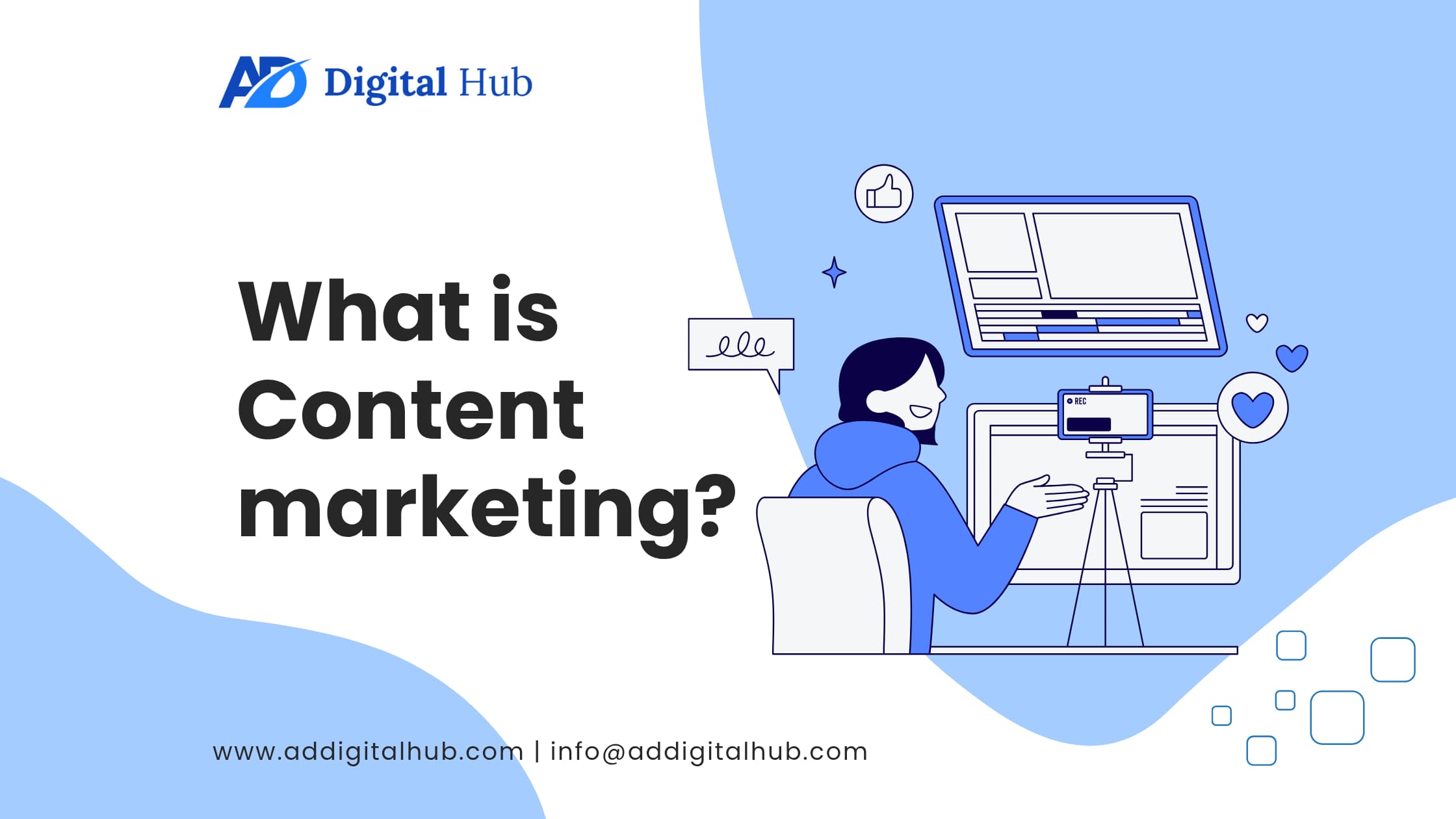Do you feel overwhelmed by the word “content marketing”? You are not alone. In a world where attention spans are shorter than ever – only 8 seconds, according to Microsoft research – marketers compete to engage with their consumers in meaningful ways. This is where content marketing comes in.
This guide is for anyone who owns a small business, is new to digital marketing, is a blogger, or works as a freelancer. No jargon. No meaningless buzzwords. Just a simple, step-by-step explanation of what content marketing is, why it is important, and how you can get started right away, even if you have no prior experience.
Key Takeaways
- Content marketing is about providing valuable, relevant content to attract and engage your audience.
- It helps you build trust, authority, and customer loyalty by solving real problems and answering questions.
- Content marketing’s Common formats include blogs, videos, infographics, podcasts, ebooks, and social media posts.
- Every business type—startups, freelancers, personal brands, and nonprofits—can benefit from content marketing.
- Success depends on knowing your audience, setting clear goals, and being consistent with quality content.
- Great content marketing examples (like HubSpot and Canva) focus on user needs, consistency, and diverse formats.
- Measure your success using metrics like traffic, engagement, leads, and conversions with tools like Google Analytics.
- A clear strategy is essential to guide content creation, distribution, and performance tracking.
What is Content Marketing?
Content marketing is a strategic approach to developing and sharing valuable, relevant information with the goal of attracting and engaging a specific audience—without directly pushing a product or service. The idea is to gain trust, educate, or entertain people so that when it comes time to buy, they choose you.
How does content marketing differ from traditional marketing?
The key difference between traditional marketing and content marketing is a change in thinking, approach, and focus. Traditional marketing uses methods like advertising and direct mail to reach out to customers, but content marketing focuses on providing meaningful, relevant, and engaging material to attract and nurture an audience. Content marketing emphasizes a “pull” approach, luring customers with fascinating information, whereas traditional marketing often takes a “push” approach, directly advertising items or services.
The Purpose and Goals of Content Marketing
Attracting Your Target Audience
The very first goal of content marketing is to attract the correct audience to your brand. Instead of throwing your message to everyone, offer excellent content that focuses on your prospective customer’s specific requirements, issues, or challenges. Whether it’s a blog post, video, or podcast, your content allows people to find you naturally via search engines, social media, or referrals.
Building Trust and Authority
People begin to trust your company when your content educates, informs, or solves problems without attempting to sell them anything. This gradually establishes you as an expert in your area of expertise. Readers grow to rely on you for insights—and when they’re ready to buy, they’ll go with the company that assisted them rather than the one that merely advertised to them.
Driving Profitable Customer Actions
Content marketing is more than just attracting attention; it also encourages important actions. This might be subscribing to your email list, downloading a guide, scheduling a call, or making a purchase. With the correct content at each stage of the customer journey, you can guide them from interest to decision, all while adding value along the way.
Key Components of Content Marketing
To get the most out of content marketing, you need more than just a few blog posts or social media updates. It adopts an organized strategy based on a few important components. When these are in place, your content has the potential to attract, trust, and convert.
Valuable & Relevant Content
At the heart of content marketing is value. Your content should solve a problem, answer a question, or provide value to your readers. It isn’t about how much information you produce; it’s about how useful it is. Relevant content addresses your audience’s immediate requirements, interests, or search intent.
Consistency
Content marketing is not a one-time effort; it is a long-term game. Consistency creates recognition, trust, and engagement over time. Whether it’s one blog post per week or a monthly email, sticking to a regular schedule lets your audience know what to anticipate and keeps your brand front and center mind.
Target Audience Understanding
To produce content that actually resonates, you must first understand your target audience. That entails analyzing your target audience’s demographics, interests, pain areas, and objectives. When you have a clear picture of your ideal consumer, you can create content that is personalized, relevant, and fresh.
Strategic Planning
Content without a plan is typically ignored. A content strategy guarantees that each piece of content contributes to your overall marketing goals. It covers content themes, formats, channels, publishing frequency, and performance indicators. Strategic planning allows you to be focused, efficient, and aligned with your brand’s objectives.
Choosing the Right Channels for circulation
Creating outstanding content is only the beginning. You should also distribute it where your target audience spends their time. This may include your blog, email list, social media sites, YouTube, or even podcasts. Your audience’s habits and the format of your material determine which channels are appropriate. Distribution is how you amplify your message and ensure that it reaches those who need it the most.
Benefits of Content Marketing
Content marketing provides long-term benefits that go beyond visibility. When done correctly, it can benefit numerous aspects of your digital strategy, from SEO to customer retention. Here’s how it can help your business grow:
Improves SEO Rankings
- High-quality content provides more stuff for search engines to index, increasing your chances of appearing in relevant search results.
- Using targeted keywords naturally in helpful content improves your chances of ranking better for the terms your audience searches for.
Builds Brand Awareness
- Consistently posting useful content increases your brand’s visibility across multiple media platforms and in front of targeted users.
- As users share or interact with your content, your brand gains recognition and trustworthiness.
Supports Lead Generation and Nurturing
- Content such as ebooks, tutorials, and webinars can entice visitors to share their contact information, converting traffic into leads.
- Nurturing emails or blog updates keep your brand top of mind and help leads make a purchase.
Boosts Customer Engagement and Loyalty
- Interactive or personalized content, such as quizzes, lessons, or newsletters, keeps your audience interested and returning.
- Helpful material fosters emotional connections and loyalty, converting one-time customers into long-term supporters.
Common Types of Content
Content marketing is not limited to a single format. Various types of content can help you reach and engage your target audience on different platforms. These are some of the most common and effective formats.
Blog Posts
- Blog posts are excellent for answering inquiries, addressing problems, and enhancing SEO ranks with keyword-optimized articles.
- They help to demonstrate your brand’s authority and competence in your industry by providing useful, detailed information.
Videos/ short videos
- Videos are very helpful because they can swiftly convey complex concepts using images and storytelling.
- They perform well on various social media platforms, websites, and YouTube, allowing you to reach a larger audience.
Infographics
- Infographics simplify complex data or ideas by mixing pictures with brief, attractive text.
- They are widely shareable and can help increase your brand’s visibility on social media and blogs.
Podcasts
- Podcasts allow you to connect with your audience while they are commuting, exercising, or multitasking.
- Hosting expert interviews or conversations can help you establish your brand as a thought leader in your field.
Ebooks/White papers
- Ebooks and whitepapers provide in-depth insights and are excellent lead generation tools when distributed in exchange for contact information.
- They demonstrate your brand’s knowledge and dedication to producing high-quality content.
Social Media Posts
- Social media posts let you keep connected with your audience on a regular basis by giving fast updates, suggestions, and promotions..
- Platforms such as Instagram, LinkedIn, and X (Twitter) enable you to cultivate a community around your company through constant participation.
Who Needs Content Marketing?
Content marketing isn’t only for large brands, corporations, or media companies; it’s an effective tool for anyone looking to create trust, reach more people, and grow online. Let’s explore who benefits the most from it.
Businesses (Small to Large)
- Whether you’re a local shop or a multinational corporation, content can help educate customers, answer problems, and boost long-term sales.
- It increases your brand’s reputation and visibility in a crowded market, helping you to stand out from competitors.
Startups
- Startups can utilize content to raise visibility from the start, rather than depending entirely on pricey advertising.
- Educational or story-driven material can assist explain your product, mission, and value in an engaging manner.
Freelancers
- Freelancers can showcase their skills, experience, and personality through blogs, videos, images, or case studies.
- Content helps any individual or business create a portfolio that attracts clients and builds trust – even before the first interaction.
Personal Brands
- Coaches, consultants, and creators can enhance their personal brand by offering exclusive insights or behind-the-scenes stories.
- Content fosters community and establishes you as an expert in your field of interest or profession.
Non-profits
- Nonprofits can utilize content to increase awareness, share impact stories, and motivate people to take action or donate.
- Blog articles, videos, and social media updates all help to strengthen emotional relationships and increase long-term support.
Getting Started with Content Marketing
If anyone thinks that starting content marketing is very difficult, then they are not right. Let me help you make your task easier. With some smart steps, you can start building your online presence and attract the right audience. Here’s how to lay a strong foundation:
Identify Your Audience
Before you start creating content, be sure you know who you’re talking to. What are their challenges, objectives, and interests? Knowing your target customer allows you to develop content that truly resonates and offers value. You don’t have to reach everyone; simply reach the right individuals.
Set Clear Goals
Your content should have a purpose. Are you looking to improve website traffic, generate leads, raise brand awareness, or enhance sales? Clear goals can help you make better content decisions and track your success. Each thing you develop should get you one step closer to your goal.
Choose Your Primary Content Format
Choose one content format to focus on at the start, such as blog posts, videos, or podcasts. This helps you maintain consistency and gain confidence. Choose a format that is appropriate for your strengths and your audience’s preferences. You can always extend into other forms later.
Start with One Channel
Instead of trying to be anywhere, focus on one distribution channel at first—your blog, YouTube, LinkedIn, or email newsletter. This keeps things manageable and allows you to study what works. Once you’ve gained popularity, you may expand and repurpose your content across several platforms.
Examples of Great Content Marketing
Looking at real-world content marketing examples can help you understand how effective content marketing works. Let’s explore how some well-known brands use content to grow, engage, and convert.
Brief Case Studies (e.g., HubSpot, Canva)
HubSpot
HubSpot established its brand by providing free, comprehensive training resources on marketing, sales, and customer support. They built a loyal audience by offering blogs, ebooks, templates, and online courses. Their content strategy transformed them into a trusted authority, resulting in enormous increases in leads and conversions.
Canva
Canva’s blog and design school provide user-friendly tutorials, recommendations, and templates to help them master visual content—even if they lack design experience. Their strategy focuses on solving user problems while demonstrating Canva’s capabilities. It’s a clever combination of assistance and product promotion.
What Made Their Strategy Successful
- Audience-first approach: Both brands delve deeply into their customers’ requirements and concerns before creating content that directly answers them.
- Consistency and quality: Their content is not just frequent, but also of great quality—well-written, graphically appealing, and informative.
- Clear goals and CTAs:Each piece of content serves an objective, such as increasing brand awareness, generating leads, or retaining customers, and includes a clear call to action.
- Diverse formats: They use a variety of forms, including blog articles, videos, templates, and webinars, to engage users across channels.
These examples demonstrate that content marketing success comes from focusing on the audience, solving real-world problems, and maintaining consistency over time.
How Do You Measure Content Marketing Success?
Creating content is just one part of the content marketing journey. To know if content is really working, you need to track the right metrics and use tools that provide clear insights. Let’s learn how to measure the impact of your content.
Key Metrics to Track
- Traffic: Platforms such as Google Analytics allow you to track how many people visit your content. Examine page views, unique visitors, and where they’re coming from.
- Engagement: Metrics like time on page, scroll depth, comments, and social shares indicate whether your content is attracting attention.
- Leads: Monitor the number of users who sign up for a newsletter or download a free resource.
- Conversions: Discover how many leads convert into paying clients or achieve another goal, such as scheduling a call or purchasing a product.
Tools to Help You Analyze Performance
- Google Analytics: Ideal for monitoring website traffic, behavior flow, and user demographics.
- Google Search Console: Allows you to observe which search terms drive traffic and how your content ranks in search results.
- HubSpot or Mailchimp: Useful for monitoring lead generation, email performance, and conversion rates.
- Social Media Insights: Platforms such as LinkedIn, Instagram, and Facebook provide detailed interaction data for individual posts.
What Success Looks Like at Different Stages
- Early Stage:If you’re just starting out, success is increasing awareness—look for more traffic and social shares.
- Growth Stage: As your strategy matures, focus on engagement, lead generation, and email list growth.
- Established Stage: At this point, look at deeper measures like ROI, client retention, and how content supports long-term sales and loyalty.
Tracking results on a regular basis allows you to develop and change your content approach. Success takes time, but with the correct data, you can always see where you’re going.
What’s Next: Planning Your Content Strategy
By now you understand what content marketing is and why it is important, so what should be the next step? The next step is to create a strategy that ties everything together. A content strategy is your roadmap. It helps you decide what content to create, who it is for, where to publish it and how to measure its impact.
Even great content can be useless without a clear strategy. With a precise plan, you can consistently reach the right people, deliver value, and get real results – whether you measure it in more traffic, leads, or loyal customers.
In the next blog, we’ll go over the step-by-step process of developing your content marketing strategy, from setting goals and brainstorming content ideas to selecting the best channels and creating a content schedule.
Whether you’re just starting out or ready to take your content to the next level, Blog will be your hands-on blueprint for success.
FAQs About Content Marketing
Is content marketing the same as blogging?
Not exactly. Blogging is one form of content marketing, but the strategy includes much more—like videos, social media, email newsletters, infographics, and more. Content marketing focuses on delivering value through any content format that builds trust and drives action.
How long does it take to see results from content marketing?
Typically 3 to 6 months. Content marketing is a long-term strategy. While some content may perform well quickly, consistent results—like traffic, leads, and SEO rankings—usually take time to build up.
Can beginners do content marketing without a big budget?
Yes! Many successful content marketers started with zero budget. All you need is valuable content, consistency, and basic tools (many of which are free). Over time, results grow as your content library expands.
What type of content works best for beginners?
Blog posts and social media updates are great starting points. They’re easy to create, affordable, and effective for building trust, sharing expertise, and improving search visibility.
Do I need to be a great writer to succeed in content marketing?
Not at all. Clear, helpful content works better than fancy writing. Focus on solving your audience’s problems. Tools like grammar checkers and AI editors can help polish your content.
Final Thought
If content marketing was previously a difficult task for you, we hope this guide can make it easier for you.
Basically, content marketing means providing real value – no gimmicks, no hard sell. Whether you’re a small business owner, a freelancer, or just starting out in digital marketing, content marketing gives you the power to attract, educate, and build trust with your ideal audience.
You do not need to be a writing specialist or have a large budget. What matters most is consistency, clarity, and a commitment to helping others. When your content solves actual problems or answers real questions, it becomes more than simply words; it becomes a valuable resource.
Remember, every blog post, video or infographic is a chance to grow your authority and build deeper relationships. And the best part? Your efforts add up over time. So, take everything you learned here and start with a useful piece of content. Keep learning, stay authentic and create with purpose. That’s the real key to long-term content marketing success.



